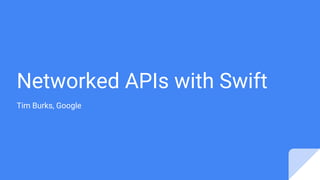Networked APIs with swift
- 1. Networked APIs with Swift Tim Burks, Google
- 2. Use Swift to connect to powerful cloud services and even create some of your own.
- 3. We'll use a Google Cloud Shell and a Google API in our examples. Sign up here: https://cloud.google.com/free
- 4. What is a Networked API? From the Google Cloud APIs Design Guide: “Application Programming Interfaces that operate across a network of computers. They communicate using network protocols including HTTP, and are frequently produced by different organizations than the ones that consume them.”
- 5. API Styles 1. Remote Procedure Call (RPC) 2. Representational State Transfer (REST)
- 6. What is a REST API? From the Richardson Maturity Model (as described by Martin Fowler): Level 3 Hypermedia Controls Level 2 HTTP Verbs Level 1 Resources Level 0 HTTP
- 7. Hypermedia Controls??? HATEOAS (Hypertext As The Engine Of Application State) <appointment> <slot id = "1234" doctor = "mjones" start = "1400" end = "1450"/> <patient id = "jsmith"/> <link rel = "/linkrels/appointment/cancel" uri = "/slots/1234/appointment"/> <link rel = "/linkrels/appointment/addTest" uri = "/slots/1234/appointment/tests"/> <link rel = "self" uri = "/slots/1234/appointment"/> <link rel = "/linkrels/appointment/changeTime" uri = "/doctors/mjones/slots?date=20100104@status=open"/> <link rel = "/linkrels/appointment/updateContactInfo" uri = "/patients/jsmith/contactInfo"/> <link rel = "/linkrels/help" uri = "/help/appointment"/> </appointment> (source: Martin Fowler)
- 8. REST Requirements - Roy Fielding ● A REST API should not be dependent on any single communication protocol. ● A REST API should not contain any changes to the communication protocols aside from filling-out or fixing the details of underspecified bits of standard protocols. ● A REST API should spend almost all of its descriptive effort in defining the media type(s) used for representing resources and driving application state, or in defining extended relation names and/or hypertext-enabled markup for existing standard media types. ● A REST API must not define fixed resource names or hierarchies (an obvious coupling of client and server). ● A REST API should never have “typed” resources that are significant to the client. ● A REST API should be entered with no prior knowledge beyond the initial URI (bookmark) and set of standardized media types that are appropriate for the intended audience (i.e., expected to be understood by any client that might use the API).
- 9. 1. HTTP/HTTPS a. Paths describe resources (nouns) b. HTTP verbs describe actions 2. JSON Payloads REST in Practice
- 10. The OpenAPI Specification The OpenAPI Specification (OAS) defines a standard, programming language-agnostic interface description for REST APIs, which allows both humans and computers to discover and understand the capabilities of a service without requiring access to source code, additional documentation, or inspection of network traffic.
- 11. Find OpenAPI descriptions on the web
- 12. Generate API support code from OpenAPI.
- 13. Make HTTP requests with Swift 1. Prepare a URL. 2. Prepare a request. 3. Perform the request.
- 14. 1. Prepare a URL // build URLs with the URLComponents class var urlComponents = URLComponents(string:urlString)! // if necessary, add query parameters var queryItems : [URLQueryItem] = [] for (key, value) in parameters { // [String:String] of parameters queryItems.append(URLQueryItem(name: key, value: value)) } urlComponents.queryItems = queryItems // build the URL let url = urlComponents.url!
- 15. 2. Prepare a request // represent the request with the URLRequest class var request = URLRequest(url:url) // add any needed request headers request.setValue(authorization, forHTTPHeaderField:"Authorization") // if necessary, set the request method (“GET” is the default) request.httpMethod = method
- 16. 3. Perform the request // use the URLSession class to manage request activity let session = URLSession(configuration: URLSessionConfiguration.default) // a URLSessionDataTask handles a specific request let task: URLSessionDataTask = session.dataTask(with:request) {(data, response, error) -> Void in // This block gets called when the request completes. // NOTE: It will run on a separate thread. callback(data, response, error) } // do something else...
- 17. 4. Make synchronous calls with URLSessionDataTask and DispatchSemaphore // Usually we want to handle network calls asynchronously. // But sometimes (e.g. command-line tools) we want to wait for their results. // DispatchSemaphore helps us safely communicate between threads let sem = DispatchSemaphore(value: 0) let task: URLSessionDataTask = session.dataTask(with:request) {(data, response, error) -> Void in callback(data, response, error) // Use this to signal the end of the task sem.signal() } // This blocks until signal() is called _ = sem.wait(timeout: DispatchTime.distantFuture)
- 18. The Authorization Problem How do we tell an API server that it’s ok to respond to our requests?
- 19. Authorization We need to provide a token: var request = URLRequest(url:url) request.httpMethod = method request.httpBody = ... // add any needed request headers request.setValue(authorization, forHTTPHeaderField:"Authorization") How do we get that?
- 20. OAuth2 Authorization Flow For an implementation in Swift, see BrowserTokenProvider.swift Client Service Authorization URL Sign-In Page (HTML) Human Confirmation Browser Redirect w/ Code Token Request (Code) Token Web Browser
- 21. Easier ways to get tokens (1 of 2) If you’re running inside a VM on Google Cloud Platform, you can get a token from the Google Cloud Metadata Service. % curl http://metadata/computeMetadata/v1/instance/service-accounts/default/token {"access_token":"ya29.GqUBUgXcBmIt7vfHsWJT4qVzdhWxwEb2f3tamcA6ykrIsEANZfQnoH0HDCBnlCztLw cD47w7YENghIucNUIIypLId4C5dXc4H8D93e17MrSbGRe4ipfoQhxPCIhIU3KJsvFjel0HcN2iwf8xURv2z1lWiN 2jkZjzLiMRWPKfSvtBVzuWkIo5uZ5u25IXle3tJ4SICh0-516sU84DFu0wkPO-q1xGpiff","expires_in":179 9,"token_type":"Bearer"} Then pass “Bearer “ + access_token as the Authorization header. See GoogleCloudMetadataTokenProvider.swift.
- 22. Easier ways to get tokens (2 of 2) If you’re calling a Google API from anywhere, you can use a Service Account. 1. Create and download the account credentials. 2. Create a JWT token and sign it with the account credentials. 3. POST the signed token to the Google Account Service and get a token! See ServiceAccountTokenProvider.swift.
- 23. Aside: Build an HTTP server with swift-server/http
- 24. What about RPC?
- 25. It’s just a function call. service Echo { // Immediately returns an echo of a request. rpc Get(EchoRequest) returns (EchoResponse) {} }
- 32. 10 billion+ API calls every second
- 33. Protocol Buffers are a language-neutral, platform-neutral, extensible mechanism for serializing structured data.
- 34. “Protocol Buffers” means several things 1. A serialization mechanism 2. An interface description language 3. A methodology
- 35. Protocol Buffer Serialization It’s just a stream of bytes [field_number<<3 + wire_type] [length if necessary] [data]... $ hexdump /tmp/request.bin 0000000 0a 05 68 65 6c 6c 6f 0a is “0000 1010”, so field_number = 1 and wire_type = 2
- 36. Protocol Buffers aren’t just for networking class UserData { static let sharedInstance = UserData() public var user : Models_User init() { // read info from UserDefaults if let userdata = UserDefaults.standard.data(forKey:"user") { do { user = try Models_User(serializedData:userdata) } catch { user = Models_User() } } else { user = Models_User() } } func save() { DispatchQueue.main.async { do { try UserDefaults.standard.set(self.user.serializedData(), forKey:"user") } catch (let error) { print("SAVE ERROR (error)") } } }
- 37. A Data Definition Language syntax = "proto3"; package models; message PlantList { string id = 1; string name = 2; repeated PlantListItem plants = 11; } message PlantListItem { string id = 1; string botanical_name = 2; } message User { string id = 1; string name = 2; repeated PlantList plantLists = 3; }
- 40. A Methodology % protoc models.proto --swift_out=. # # This runs a plugin called protoc-gen-swift # # The plugin generates a Swift source file that implements # the data structures defined in models.proto and code # for reading and writing them as serialized bytes. #
- 42. Build a Swift client and service with gRPC
- 43. echo.proto package echo; service Echo { // Immediately returns an echo of a request. rpc Get(EchoRequest) returns (EchoResponse) {} // Splits a request into words and returns each word in a stream of messages. rpc Expand(EchoRequest) returns (stream EchoResponse) {} // Collects a stream of messages and returns them concatenated when the caller closes. rpc Collect(stream EchoRequest) returns (EchoResponse) {} // Streams back messages as they are received in an input stream. rpc Update(stream EchoRequest) returns (stream EchoResponse) {} } message EchoRequest { // The text of a message to be echoed. string text = 1; } message EchoResponse { // The text of an echo response. string text = 1; }
- 45. EchoService.swift (1/3) class EchoProvider : Echo_EchoProvider { // get returns requests as they were received. func get(request : Echo_EchoRequest, session : Echo_EchoGetSession) throws -> Echo_EchoResponse { var response = Echo_EchoResponse() response.text = "Swift echo get: " + request.text return response } // expand splits a request into words and returns each word in a separate message. func expand(request : Echo_EchoRequest, session : Echo_EchoExpandSession) throws -> Void { let parts = request.text.components(separatedBy: " ") var i = 0 for part in parts { var response = Echo_EchoResponse() response.text = "Swift echo expand ((i)): (part)" try session.send(response) i += 1 sleep(1) } }
- 46. EchoService.swift (2/3) // collect collects a sequence of messages and returns them concatenated when the caller closes. func collect(session : Echo_EchoCollectSession) throws -> Void { var parts : [String] = [] while true { do { let request = try session.receive() parts.append(request.text) } catch Echo_EchoServerError.endOfStream { break } catch (let error) { print("(error)") } } var response = Echo_EchoResponse() response.text = "Swift echo collect: " + parts.joined(separator: " ") try session.sendAndClose(response) }
- 47. EchoService.swift (3/3) // update streams back messages as they are received in an input stream. func update(session : Echo_EchoUpdateSession) throws -> Void { var count = 0 while true { do { let request = try session.receive() count += 1 var response = Echo_EchoResponse() response.text = "Swift echo update ((count)): (request.text)" try session.send(response) } catch Echo_EchoServerError.endOfStream { break } catch (let error) { print("(error)") } } try session.close() } }
- 48. main.swift (1/3) // Unary if client == "get" { var requestMessage = Echo_EchoRequest() requestMessage.text = message print("Sending: " + requestMessage.text) let responseMessage = try service.get(requestMessage) print("get received: " + responseMessage.text) } // Server streaming if client == "expand" { var requestMessage = Echo_EchoRequest() requestMessage.text = message print("Sending: " + requestMessage.text) let expandCall = try service.expand(requestMessage) {result in } var running = true while running { do { let responseMessage = try expandCall.receive() print("Received: (responseMessage.text)") } catch Echo_EchoClientError.endOfStream { print("expand closed") running = false } } }
- 49. main.swift (2/3) // Client streaming if client == "collect" { let collectCall = try service.collect() {result in } let parts = message.components(separatedBy:" ") for part in parts { var requestMessage = Echo_EchoRequest() requestMessage.text = part print("Sending: " + part) try collectCall.send(requestMessage) {error in print(error)} sleep(1) } let responseMessage = try collectCall.closeAndReceive() print("Received: (responseMessage.text)") }
- 50. main.swift (3/3) // Bidirectional streaming if client == "update" { let updateCall = try service.update() {result in} DispatchQueue.global().async { var running = true while running { do { let responseMessage = try updateCall.receive() print("Received: (responseMessage.text)") } catch Echo_EchoClientError.endOfStream { print("update closed") latch.signal() break } catch (let error) { print("error: (error)") } } } ... ... let parts = message.components(separatedBy:" ") for part in parts { var requestMessage = Echo_EchoRequest() requestMessage.text = part print("Sending: " + requestMessage.text) try updateCall.send(requestMessage) {error in print(error)} sleep(1) } try updateCall.closeSend() // Wait for the call to complete. latch.wait() } }














![1. Prepare a URL
// build URLs with the URLComponents class
var urlComponents = URLComponents(string:urlString)!
// if necessary, add query parameters
var queryItems : [URLQueryItem] = []
for (key, value) in parameters { // [String:String] of parameters
queryItems.append(URLQueryItem(name: key, value: value))
}
urlComponents.queryItems = queryItems
// build the URL
let url = urlComponents.url!](https://image.slidesharecdn.com/networkedapiswithswift-180504153220/85/Networked-APIs-with-swift-14-320.jpg)




















![Protocol Buffer Serialization
It’s just a stream of bytes
[field_number<<3 + wire_type] [length if necessary] [data]...
$ hexdump /tmp/request.bin
0000000 0a 05 68 65 6c 6c 6f
0a is “0000 1010”, so
field_number = 1 and wire_type = 2](https://image.slidesharecdn.com/networkedapiswithswift-180504153220/85/Networked-APIs-with-swift-35-320.jpg)










![EchoService.swift (2/3)
// collect collects a sequence of messages and returns them concatenated when the caller closes.
func collect(session : Echo_EchoCollectSession) throws -> Void {
var parts : [String] = []
while true {
do {
let request = try session.receive()
parts.append(request.text)
} catch Echo_EchoServerError.endOfStream {
break
} catch (let error) {
print("(error)")
}
}
var response = Echo_EchoResponse()
response.text = "Swift echo collect: " + parts.joined(separator: " ")
try session.sendAndClose(response)
}](https://image.slidesharecdn.com/networkedapiswithswift-180504153220/85/Networked-APIs-with-swift-46-320.jpg)



